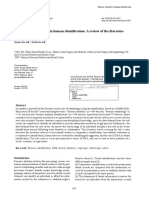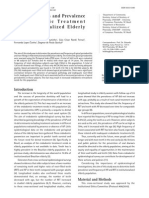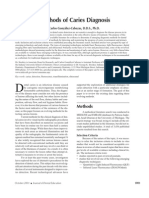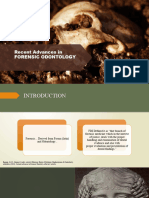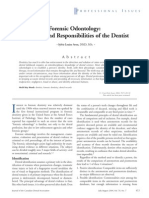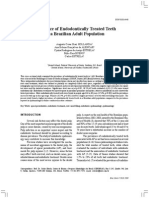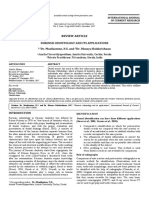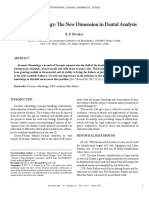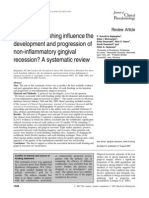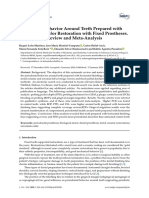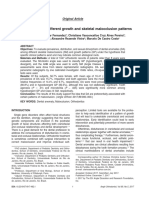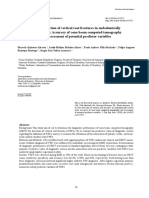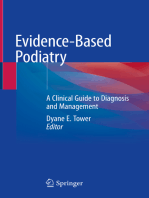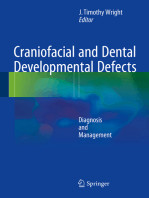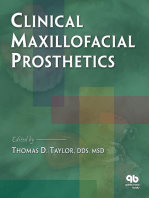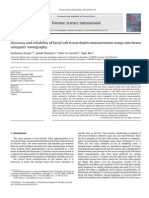0 ratings0% found this document useful (0 votes)
140 viewsForensic Dentistry in Human Identification A Review of The Literature
Forensic Dentistry in Human Identification A Review of The Literature
Uploaded by
Ridwan FajiriJurnal Forensik
Copyright:
© All Rights Reserved
Available Formats
Download as PDF, TXT or read online from Scribd
Forensic Dentistry in Human Identification A Review of The Literature
Forensic Dentistry in Human Identification A Review of The Literature
Uploaded by
Ridwan Fajiri0 ratings0% found this document useful (0 votes)
140 views6 pagesJurnal Forensik
Original Title
Forensic Dentistry in Human Identification a Review of the Literature
Copyright
© © All Rights Reserved
Available Formats
PDF, TXT or read online from Scribd
Share this document
Did you find this document useful?
Is this content inappropriate?
Jurnal Forensik
Copyright:
© All Rights Reserved
Available Formats
Download as PDF, TXT or read online from Scribd
Download as pdf or txt
0 ratings0% found this document useful (0 votes)
140 views6 pagesForensic Dentistry in Human Identification A Review of The Literature
Forensic Dentistry in Human Identification A Review of The Literature
Uploaded by
Ridwan FajiriJurnal Forensik
Copyright:
© All Rights Reserved
Available Formats
Download as PDF, TXT or read online from Scribd
Download as pdf or txt
You are on page 1of 6
e162
J Clin Exp Dent. 2014;6(2):e162-7. Forensic dentistry in human identifcation
Journal section: Oral Medicine and Pathology
Publication Types: Review
Forensic dentistry in human identifcation: A review of the literature
Javier Ata-Ali
1
, Fadi Ata-Ali
2
1
DDS, MS. Public Dental Health Service. Master in Oral Surgery and Medicine. Master in Oral Surgery and Implantology. Va-
lencia University Medical and Dental School
2
DDS. Valencia University Medical and Dental School
Correspondence:
Public Dental Health Service
Arnau de Vilanova Hospital
San Clemente Street 12
46015-Valencia, Spain
javiataali@hotmail.com
Received: 23/11/2013
Accepted: 23/12/2013
Abstract
An update is provided of the literature on the role of odontology in human identifcation, based on a PubMed-Me-
dline search of the last 5 years and using the terms: forensic dentistry (n = 464 articles), forensic odontology (n
= 141 articles) and forensic dentistry identifcation (n = 169 articles). Apart from these initial 774 articles, others
considered to be important and which were generated by a manual search and cited as references in review articles
were also included. Forensic dentistry requires interdisciplinary knowledge, since the data obtained from the oral
cavity can contribute to identify an individual or provide information needed in a legal process. Furthermore, the
data obtained from the oral cavity can narrow the search range of an individual and play a key role in the victim
identifcation process following mass disasters or catastrophes. This literature search covering the last 5 years
describes the novelties referred to buccodental studies in comparative identifcation, buccodental evaluation in
reconstructive identifcation, human bites as a method for identifying the aggressor, and the role of DNA in dental
identifcation. The oral cavity is a rich and noninvasive source of DNA, and can be used to solve problems of a
social, economic or legal nature.
Key words: Forensic identifcation, DNA, forensic dentistry, rugoscopy, cheiloscopy, saliva.
Ata-Ali Javier, Ata-Ali Fadi. Forensic dentistry in human identifcation:
A review of the literature. J Clin Exp Dent. 2014;6(2):e162-7.
http://www.medicinaoral.com/odo/volumenes/v6i2/jcedv6i2p162.pdf
Article Number: 51387 http://www.medicinaoral.com/odo/indice.htm
Medicina Oral S. L. C.I.F. B 96689336 - eISSN: 1989-5488
eMail: jced@jced.es
Indexed in:
Pubmed
Pubmed Central (PMC)
Scopus
DOI System
doi:10.4317/jced.51387
http://dx.doi.org/10.4317/jced.51387
Introduction
Forensic dentistry involves the processing, review, eva-
luation and presentation of dental evidence with the pur-
pose of contributing scientifc and objective data in legal
processes. Forensic dentists require knowledge encom-
passing a number of disciplines, since the dental records
obtained can identify an individual or afford the infor-
mation needed by the authorities to establish neglect,
fraud or abuse
(1). Dental identifcation can have three
different applications
(2):
(a) Comparative identifcation, in which the postmortem
dental records are compared with the antemortem re-
cords of an individual in order to establish whether both
records correspond to the same person.
(b) The obtainment of dental information to narrow the
search for an individual when the antemortem records
are not available and there are no possible data referred
to the identity of the subject.
e163
J Clin Exp Dent. 2014;6(2):e162-7. Forensic dentistry in human identifcation
(c) Identifcation of victims following mass disasters or
catastrophes.
Traditionally, comparisons have been made between
postmortem dental records and the antemortem (li-
ving) records (presence of dental fllings, endodontic
treatments, crowns or bridges, radiological studies to
verify the clinical fndings, the presence of malocclu-
sions or dental fractures, etc.) to determine whether both
records correspond to the same individual. Such techni-
ques are now less widely used, however, due to the in-
creased effciency and availability of molecular biologi-
cal techniques
(3). In this context, the enamel and dentin
layer isolate the pulp cavity from the exterior, thereby
affording a valuable source of DNA(4). A number of
identifcation techniques are used by forensic dentists,
including rugoscopy, cheiloscopy (lip prints), the ob-
tainment of imprints, or the use of molecular techniques
such as polymerase chain reaction (PCR) for analyzing
the DNA contained in dental pulp tissue (5).
The present study analyzes the literature published du-
ring the last 5 years, offering a description of the no-
velties referred to buccodental studies in comparative
identifcation, buccodental evaluation in reconstructive
identifcation, human bites as a method for identifying
the aggressor, and the role of DNA in dental identifca-
tion.
Material and Methods
A PubMed-Medline search was made of the last 5 years
(1 October 2007 to 1 October 2012) and using the terms:
forensic dentistry (n = 464 articles), forensic odon-
tology (n = 141 articles) and forensic dentistry identi-
fcation (n = 169 articles). Apart from these initial 774
articles, others considered to be important and which
were generated by a manual search and cited as referen-
ces in review articles were also included. In selecting the
studies, we reviewed the titles and abstracts to identify
relevant publications, of which the complete text was
then obtained. The publications generated by the search
were divided into three groups: buccodental studies in
comparative identifcation, buccodental evaluation in re-
constructive identifcation (determination of age; rugos-
copy and cheiloscopy; determination of gender), human
bites as a method for identifying the aggressor, and the
role of DNA in dental identifcation.
Buccodental Study in Comparative Identifca-
tion
Provided the antemortem records are available for com-
parison, the dental identifcation process allows us to
identify an individual
(2). Such records may consist of
study models, X-rays or dental treatments such as res-
torations. Recently, an intelligent dental identifcation
system (IDIS) has been developed that increases the
effcacy and shortens the dental identifcation times with
small margins of error (0-1.19%)
(6). The similarities and
discrepancies between the antemortem and postmortem
records must be taken into account in the comparative
process. The discrepancies may be either explainable
(e.g., a mesio-occlusal silver amalgam flling found to
be mesio-occlusal-distal after death) or unexplainable
(e.g., the presence of a tooth in the postmortem records
that appears as missing in the antemortem records) in
which case identifcation is discarded
(7). Table 1 shows
the different types of identifcation established by the
American Association of Forensic Dentistry
(8).
The available statistical data indicate that the dental me-
thods contribute to the identifcation of major catastro-
phe victims in up to 80% of the cases
(9). The percentage
of identifcations based on dental methods in major ca-
tastrophes depends on the nature of the catastrophe, the
nationality of the victims, the incidence of the different
types of dental treatments, the availability of adequate
dental records, and the degree of deterioration of the tee-
th
(9).
Buccodental Study In Reconstructive Iden-
tifcation
- Determination of age
The teeth with their different development stages offer a
noninvasive method for determining the age of an indi-
vidual
(10). In the year 1950, Gustafson
(11) was the frst
Positive dental identity - Suffcient agreement between the antemortem and postmortem data to establish that they
correspond to the same individual
- Absence of unexplainable discrepancies
- At least 12 coincident features
- Probability of coincidence with another person 1/10,000
Probable dental identity - Strong evidence, though other biological, physical, technical or tactic data are needed
- Between 6 and 11 coincident features
- Probability of coincidence with another person 1/100
Possible dental identity - No suffcient characteristics for positive identifcation
- Existence of explainable discrepancies
- Absence of excluding characteristics
- If there are 5 coincidences or less, other techniques must be used to determine the identity
of the individual
Discarded dental identity - Existence of an unexplainable discrepancy.
- Need for new data (such as X-rays) and defnition of the identifcation technique used, in
order to discard errors
Table 1. Types of dental identifcation (8).
e164
J Clin Exp Dent. 2014;6(2):e162-7. Forensic dentistry in human identifcation
to publish a method for estimating the age of a person
from the teeth, based on 6 criteria related to hard dental
tissue changes that progress with advancing age: occlu-
sal wear, secondary and tertiary dentin layers, cement
thickness, the extent of root resorption, the length of the
root transparency, and the height of gingival attachment.
Gustafson assigned a score of 0-3 to all these factors
(according to intensity) - the results being subjective,
however, since the scores were not included in an inte-
grating scale. Lamendin et al.
(12) in turn established a
technique for estimating the age of an adult using single-
root teeth. This system involved the measurement of two
parameters related to age: gingival recession and root
transparency (a phenomenon not seen before 20 years of
age, and which is due to the formation of hydroxyapatite
deposits within the dentinal tubules). These authors mea-
sured the maximum length of the transparency on the
vestibular surface of the root, which is where the pheno-
menon is most apparent. The mean error associated with
this technique is signifcantly lower than in the case of
the method developed by Gustafson
(11) (8.92.2 and
14.23.4 years, respectively). Another method for esti-
mating dental age is based on the superposition of den-
tal cement layers, whereby the chronological age of the
individual is related to the number of deposited cement
layers and to the age of eruption of the tooth. Condon et
al.
(13), based on the analysis of 80 teeth corresponding
to individuals of known age, established a correlation
rate between true age and estimated age of 78%, with
standard errors according to dental class of between 4.7
and 9.7 years. Czermak et al.
(14) facilitated the search
for the best location to calculate the cement layers at
microscopic level, based on the software-mediated ob-
tainment of images thereby reducing the human error
factor associated with subjectiveness and fatigue.
The method developed by Dermirjian et al.
(15) invol-
ves evaluation of the degree of mineralization of the
mandibular teeth, with the designation to each tooth of
a value from A to H depending on its degree of develo-
pment. This in turn is followed by the designation of a
score according to the gender of the individual. Lastly,
the values of each tooth are added and compared with a
conversion table to establish the chronological age of the
subject. Mohite et al.
(16) studied the radiological and
histological changes that take place in mandibular bone
with the purpose of estimating the dental age of the in-
dividual. Radiologically, and taking the mental foramen
as reference, the mandibular ramus was seen to increase
in length with advancing age this process being more
gradual after 50 years of age with a decrease in the
alveolar process as measured in the craniocaudad direc-
tion. Osteoblastic activity was found to decrease with
advancing age, with expansion of the Haversian canal
system secondary to increased remodeling within the os-
teons - this giving rise to increased porosity of the corti-
cal bone. The number of concentric laminas per osteon
decreases with age, particularly after 50 years of age.
- Rugoscopy and cheiloscopy
Rugoscopy is an identifcation technique based on the
study and analysis of the number, shape, length, direc-
tion and merging pattern of the palatal ridges or rugae
(rugosities). Table 2 shows the rugae classifcation pro-
posed by Lysell
(17) and posteriorly modifed by Tho-
mas and Kotze
(18).
Table 2. Palatal rugae classifcation of Tho-
mas and Kotze (18).
Criterion
Length
Primary rugae:
A. 5-10 mm
B. 10 mm or more
Secondary rugae: 3-5 mm
Shape
Fragmented: less than 3 mm
Curvy
Wavy
Straight
Circular
The palatal rugae are anatomical ridges, wrinkles or
folds located on the anterior portion of the palate, im-
mediately posterior to the upper anterior teeth and the
incisive papilla, on either side of the midline
(19). The
fact that the rugae are present for life, starting from the
third month of intrauterine development; are unique to
each individual (including twins); and are relatively
well protected by the lips, teeth, Bichats fat pad and the
maxillary bones, implies that they are less affected by
decomposition and incineration. As a result, the palatal
rugae are studied as a method of identifcation, compa-
rable to the fnger prints of the individual
(20). Howe-
ver, a study
(21) found that the rugae undergo changes
in adolescence, with a marked increase in the number of
ridges after 35 years of age. In contrast, another study
(17) reported a decrease in the number of rugae after 23
years of age.
According to Ohtani et al.
(22), three situations compli-
cate identifcation based on the palatal rugae: changes in
rugae height, the presence of fat or poorly accentuated
ridges, and the absence of uncomplicated patterns. Ne-
vertheless, other elements can supplement the study of
the palatal rugae, such as the incisive papilla, the shape
of the mid-palatal raphe, and the palatal tori, where pre-
sent. One study
(22) found the percentage accuracy of
identifcation based on the palatal rugae to be 94%.
Cheiloscopy involves the study of a series of eleva-
tions and depressions that form a characteristic pattern
on the lips known as lip prints
(23). In the same way as
the fnger prints, the lip prints are permanent and cons-
tant, and are therefore unique to each individual (except
monozygous twins)
(24). A number of lip print classif-
cations have been developed, such as that published by
e165
J Clin Exp Dent. 2014;6(2):e162-7. Forensic dentistry in human identifcation
Renaud
(25), which describes 10 types of lip prints (Fig.
1), designated by letters from A to J capital letters be-
ing applied to the upper lip and lowercase letters to the
lower lip.
the basion and the incisor foramen (Ba-IF), and the inci-
sor foramen and a middle point between the two major
palatal foramens (IF-RGPF/LGPF). Statistically signi-
fcant results were obtained for IF-RGPF (p = 0.020),
IF-LGPF (p = 0.008), Ba-IF (p = 0.004) and IF-RGPF/
LGPF (p = 0.015), while the fndings for RGPF-LGPF
failed to reach statistical signifcance.
Human Bites as a Method for Identifying an
Aggressor
Consensus is currently lacking among forensic dentists
as to whether the dentition or behavior of the human skin
in response to biting action is characteristic, individual
and unique. Nevertheless, many studies have been made
to determine whether each human dentition is unique or
not
(4).
Human bite marks can be found on practically any part
of the body
(4). While in females human bites are more
commonly found on the breasts and legs secondary to
sexual assault, in males bite marks are mainly found on
the arms and shoulders
(34, 35). The diameter of the hu-
man bite typically varies between 25-40 mm. A central
Fig. 1. Lip print classifcation of Renaud (25).
Fig. 2. Types of lip print patterns (23).
- Determination of gender
The palatal rugae of an individual can be regarded as
a complement in the identifcation of gender. A study
(26) based on the methods of Thomas and Kotze
(27)
and Kapali et al.
(28) analyzed the number, length, shape
and merging pattern of the palatal rugosities, and found
convergent rugae to be more common in females and
circular ridge morphologies to be more frequent in ma-
les. Gender differences were also observed in terms of
the number and length of the rugae, though statistical
signifcance was not reached.
From a statistical perspective, Archaya et al.
(29) showed
logistic regression analysis to afford a success rate of up
to 99.2% in identifying gender on analyzing the shape of
the palatal rugae. Sherfydhin et al.
(30), in a study of ca-
nine teeth, recorded statistically signifcant differences
in the lower canines, which were seen to be narrow in fe-
males. In turn, the inter-canine distance was shorter than
in males. Another study
(31) found the size of the crown
and of Carabellis tubercle to be greater in males. Ano-
ther alternative for the determination of gender involves
the analysis of pulp tissue to establish the presence of
chromosome X (32). Lip print morphology can also help
in the determination of gender. In this context, females
more often present a vertical or intersection-shaped lip
print pattern, while ramifed or reticular lip print patterns
are more frequent in males (Fig. 2). The anatomical di-
fferences at skull base level between males and females
can also be of help. In this context, the male cranium is
signifcantly larger, thicker and heavier, and of greater
capacity than the female cranium, which in turn has sof-
ter-contoured and smaller bone crests and protuberances
(33). In a study
(33) of 100 skull bases (50 males and
50 females), measurements were made of the distances
(in mm) between the incisor foramen (IF) and the right
greater palatal foramen (RGPF)(IF-RGPF), the incisor
foramen and the left greater palatal foramen (IF-LGPF),
the right and left greater palatal foramen (RGPF-LGPF),
e166
J Clin Exp Dent. 2014;6(2):e162-7. Forensic dentistry in human identifcation
contusion zone is normally observed within the teeth
marks. Extravascular bleeding is caused by tooth pres-
sure upon the tissues directed towards the interior from
the periphery of the bite mark
(4).
The individual bite characteristics must be documen-
ted in order to positively identify the suspect. Certain
important dental features can include fractures, dental
rotations, attrition and wear, congenital malformations,
etc.
(4). The physical and biological fndings deteriorate
from the moment of the actual bite, and therefore should
be documented as quickly as possible. Saliva is deposi-
ted in the skin at the time of biting and should be collec-
ted - preferably using the double cotton swab technique
(36). Dry saliva is hard to detect, and the amylase test is
needed to identify its presence
(37).
An exact and precise impression should be obtained of
the bite surface to register all the irregularities produced
by the teeth upon the skin, employing vinyl polysiloxa-
ne, polyether or other impression materials recommen-
ded for the obtainment of imprints for fxed prostheses
(4).
The Role of DNA in Dental Identifcation
The oral cavity is a useful source of DNA. The latter
is obtained from saliva, the oral mucosal cells and the
teeth. The main DNA source is blood, though in some si-
tuations this type of sample is not available for analysis.
In teeth, DNA is found in the pulp tissue, dentin, cement,
periodontal ligament and alveolar bone (37). Due to the
resistance of the hard tissues of the teeth to environ-
mental actions such as incineration, immersion, trauma
or decomposition, pulp tissue is an excellent source of
DNA(5).
Pulp tissue is the most widely used option, since it is nor-
mally abundant and is less vulnerable to contamination
by non-human DNA. The pulp tissue samples are collec-
ted in three ways: crushing, horizontal or vertical tooth
sectioning, and through an endodontic access. Sweet
and Hildebrand
(38) were pioneers in the obtainment of
DNA by tooth crushing through cryogenization.
Pulp tissue is easier to prepare and analyze than other
sources. However, in many case the analyzed tooth lacks
pulp tissue or may have been endodontically obturated.
It also may be contaminated by microorganisms or by
non-human DNA. In such cases dentin or cement is
used for DNA extraction
(37). Forensic dentists should
incorporate these new technologies, since a number of
methods are available for the extraction of DNA from
biological samples, though no standardized protocols for
their use have been established to date
(39).
Conclusions
An analysis has been made of the literature published
during the last 5 years, offering a description of the no-
velties referred to buccodental studies in comparative
identifcation, reconstructive identifcation (determina-
tion of age, rugoscopy and cheiloscopy, determination
of gender), human bites as a method for identifying the
aggressor, and the role of DNA in dental identifcation.
The oral cavity is a rich and noninvasive source of DNA,
and can be used for the identifcation of individuals and
for providing information needed in legal processes.
References
1. Sukul B, Deb U, Ghosh S. Why a dental surgeon for identifcation
in forensic science? J Indian Med Assoc. 2010;108:769-70, 775.
2. Sweet D, DiZinno JA. Personal identifcation through dental eviden-
ce--tooth fragments to DNA. J Calif Dent Assoc. 1996;24:35-42.
3. Girish K, Rahman FS, Tippu SR. Dental DNA fngerprinting in
identifcation of human remains. J Forensic Dent Sci. 2010;2:63-8.
4. Sweet D, Pretty IA. A look at forensic dentistry--Part 2: teeth as
weapons of violence--identifcation of bitemark perpetrators. Br Dent
J. 2001;190:415-8.
5. Saxena S, Sharma P, Gupta N. Experimental studies of forensic
odontology to aid in the identifcation process. J Forensic Dent Sci.
2010;2:69-76.
6. Chomdej T, Pankaow W, Choychumroon S. Intelligent dental
identifcation system (IDIS) in forensic medicine. Forensic Sci Int.
2006;158:27-38.
7. Pretty IA, Sweet D. A look at forensic dentistry--Part 1: The role of
teeth in the determination of human identity. Br Dent J. 2001;190:359-
66.
8. American Board of Forensic Odontology. Body identifcation guide-
lines. J Am Dent Assoc. 1994;125:1244-6, 1248, 1250 passim.
9. Valenzuela A, Martin-de las Heras S, Marques T, Exposito N, Bo-
hoyo JM. The application of dental methods of identifcation to human
burn victims in a mass disaster. Int J Legal Med. 2000;113:236-9.
10. Kumar VJ, Gopal KS. Reliability of age estimation using
Demirjians 8 teeth method and India specifc formula. J Forensic Dent
Sci. 2011;3:19-22.
11. Gustafson G. Age determination on teeth. J Am Dent Assoc.
1950;41:45-54.
12. Lamendin H, Baccino E, Humbert JF, Tavernier JC, Nossintchouk
RM, Zerilli A. A simple technique for age estimation in adult corpses:
the two criteria dental method. J Forensic Sci. 1992;37:1373-9.
13. Condon K, Charles DK, Cheverud JM, Buikstra JE. Cementum
annulation and age determination in Homo sapiens. II. Estimates and
accuracy. Am J Phys Anthropol. 1986;71:321-30.
14. Czermak A, Czermak A, Ernst H, Grupe G. A new method for
the automated age-at-death evaluation by tooth-cementum annulation
(TCA). Anthropol Anz. 2006;64:25-40.
15. Demirjian A, Goldstein H, Tanner JM. A new system of dental age
assessment. Hum Biol. 1973;45:211-27.
16. Mohite DP, Chaudhary MS, Mohite PM, Patil SP. Age assessment
from mandible: comparison of radiographic and histologic methods.
Rom J Morphol Embryol. 2011;52(2):659-68.
17. Lysell L. Plicae palatinae transversae and papilla incisiva in man; a
morphologic and genetic study. Acta Odontol Scand. 1955;13:5-137.
18. Thomas CJ, Kotze TJ. The palatal ruga pattern: a new classifca-
tion. J Dent Assoc S Afr. 1983;38:153-7.
19. Shukla D, Chowdhry A, Bablani D, Jain P, Thapar R. Establis-
hing the reliability of palatal rugae pattern in individual identifca-
tion (following orthodontic treatment). J Forensic Odontostomatol.
2011;29:20-9.
20. Nayak P, Acharya AB, Padmini AT, Kaveri H. Differences in
the palatal rugae shape in two populations of India. Arch Oral Biol.
2007;52:977-82.
21. Hauser G, Daponte A, Roberts MJ. Palatal rugae. J Anat.
1989;165:237-49.
22. Ohtani M, Nishida N, Chiba T, Fukuda M, Miyamoto Y, Yoshioka
N. Indication and limitations of using palatal rugae for personal identi-
fcation in edentulous cases. Forensic Sci Int. 2008;176:178-82.
23. Sivapathasundharam B, Prakash PA, Sivakumar G. Lip prints
(cheiloscopy). Indian J Dent Res. 2001;12:234-7.
24. Caldas IM, Magalhes T, Afonso A. Establishing identity using
cheiloscopy and palatoscopy. Forensic Sci Int. 2007;165:1-9.
e167
J Clin Exp Dent. 2014;6(2):e162-7. Forensic dentistry in human identifcation
25. Renaud M. [Cheiloscopic identifcation in forensic medicine].
Nouv Presse Med. 1973;2:2617-20.
26. Saraf A. Rugae patterns as an adjunct to sex differentiation in fo-
rensic identifcation. J Forensic Odontostomatol. 2011;29:E14-9.
27. Thomas CJ, Kotze TJ. The palatal ruga pattern in six southern Afri-
can human populations. Part II: Inter-racial differences. J Dent Assoc
S Afr. 1983;38:166-72.
28. Kapali S, Townsend G, Richards L, Parish T. Palatal rugae patterns
in Australian aborigines and Caucasians. Aust Dent J. 1997;42:129-
33.
29. Acharya AB, Prabhu S, Muddapur MV. Odontometric sex
assessment from logistic regression analysis. Int J Legal Med.
2011;125:199-204.
30. Sherfudhin H, Abdullah MA, Khan N. A cross-sectional study of
canine dimorphism in establishing sex identity: comparison of two sta-
tistical methods. J Oral Rehabil. 1996;23:627-31.
31. Noss JF, Scott GR, Potter RH, Dahlberg AA, Dahlberg T. The in-
fuence of crown size dimorphism on sex differences in the Carabe-
lli trait and the canine distal accessory ridge in man. Arch Oral Biol.
1983;28:527-30.
32. da Silva RH, Sales-Peres A, de Oliveira RN, de Oliveira FT, Sales-
Peres SH. Use of DNA technology in forensic dentistry. J Appl Oral
Sci. 2007;15:156-61.
33. Nascimento Correia Lima N, Fortes de Oliveira O, Sassi C, Pica-
pedra A, Francesquini L Jr, Daruge E Jr. Sex determination by linear
measurements of palatal bones and skull base. J Forensic Odontosto-
matol. 2012;1:38-44.
34. Vale GL, Noguchi TT. Anatomical distribution of human bitemarks
in a series of 67 cases. J Forensic Sci. 1983;28:61-9.
35. Pretty IA, Sweet D. Anatomical locatios of bitemarks and asso-
ciated fndings in 101 cases from the United States. J Forensic Sci.
2000;45:812-4.
36. Sweet D, Lorente M, Lorente JA, Valenzuela A, Villanueva E. An
improved method to recover saliva from human skin: the double swab
technique. J Forensic Sci. 1997;42:320-2.
37. Muruganandhan J, Sivakumar G. Practical aspects of DNA-based
forensic studies in dentistry. J Forensic Dent Sci. 2011;3:38-45.
38. Sweet DJ, Hildebrand DP. Recovery of DNA from human teeth by
cryogenic grinding. J Forensic Sci. 1998;43:1199-202.
39. Datta P, Datta SS. Role of deoxyribonucleic acid technology in
forensic dentistry. J Forensic Dent Sci. 2012;4:42-6.
Confict of Interest
The authors declare that they have no conficts of interest.
You might also like
- Discover Biology GCE 'O' Level Science 2E Workbook (Teacher's Edn)Document162 pagesDiscover Biology GCE 'O' Level Science 2E Workbook (Teacher's Edn)Hijab100% (11)
- 965-0222 Onan 3.0-4.0KW BFA (Spec A-D) RV Genset Parts Manual (03-1986) PDFDocument33 pages965-0222 Onan 3.0-4.0KW BFA (Spec A-D) RV Genset Parts Manual (03-1986) PDFBruce EgglestonNo ratings yet
- Forensic Dentistry in Human Identification: A Review of The LiteratureDocument6 pagesForensic Dentistry in Human Identification: A Review of The LiteratureYolan Novia UlfahNo ratings yet
- Artigos Marcas de MordidaDocument7 pagesArtigos Marcas de MordidaANDSON JESUS100% (1)
- Review Article Forensic DentistryDocument5 pagesReview Article Forensic DentistryMatin Ahmad KhanNo ratings yet
- Khan Agar 2020Document8 pagesKhan Agar 2020Rama SulaksanaNo ratings yet
- Rugoscopy 1Document7 pagesRugoscopy 1shrutiNo ratings yet
- Periapical Status and Prevalence of Endodontic Treatment in Institutionalized ElderlyDocument6 pagesPeriapical Status and Prevalence of Endodontic Treatment in Institutionalized ElderlydigdouwNo ratings yet
- 05-Is Measurement of The Gingival Biotype ReliableDocument6 pages05-Is Measurement of The Gingival Biotype ReliableaemontoNo ratings yet
- Forensic Dentistry Thesis TopicsDocument4 pagesForensic Dentistry Thesis TopicsOrderPaperOnlineUK100% (2)
- Forensic DentistryDocument5 pagesForensic Dentistryزيد العراقيNo ratings yet
- Draft 1Document11 pagesDraft 1PrinceNo ratings yet
- DNA Technology PDFDocument7 pagesDNA Technology PDFmanummouraoNo ratings yet
- KAP Study in Awareness of Forensic Odontology - 1Document8 pagesKAP Study in Awareness of Forensic Odontology - 1NIVEDHA VAITHYANATHAN vNo ratings yet
- Research Paper On Forensic OdontologyDocument5 pagesResearch Paper On Forensic Odontologygz9p83dd100% (1)
- Annual Review JPD 2019 PDFDocument72 pagesAnnual Review JPD 2019 PDFNiaz AhammedNo ratings yet
- Periodontist's Role in Forensic Odontology: Dr. Bandari Purnima, Harish. K., A.R.Pradeep, Mallika, Sanjana.MDocument4 pagesPeriodontist's Role in Forensic Odontology: Dr. Bandari Purnima, Harish. K., A.R.Pradeep, Mallika, Sanjana.MSusanth AlapatiNo ratings yet
- Rad 514 Med Znanosti 13Document10 pagesRad 514 Med Znanosti 13sasdmaNo ratings yet
- Overview Forensic-Odontology 7Document7 pagesOverview Forensic-Odontology 7SOUMYA A DR, DEPT.OF DENTAL SCIENCES,SRIHERNo ratings yet
- Forensic OdontologyDocument3 pagesForensic OdontologyZupe SyachbaniahNo ratings yet
- Todentj 9 250 PDFDocument7 pagesTodentj 9 250 PDFRSU DUTA MULYANo ratings yet
- Caries DiagnosisDocument6 pagesCaries DiagnosisAbhishek SoniNo ratings yet
- Prevalence of Peg-Shaped Maxillary Permanent Lateral Incisors: A Meta-AnalysisDocument13 pagesPrevalence of Peg-Shaped Maxillary Permanent Lateral Incisors: A Meta-Analysisplayer osamaNo ratings yet
- Forensic Odontology in Pediatric Dentistry: A. Dental IdentificationDocument4 pagesForensic Odontology in Pediatric Dentistry: A. Dental IdentificationInternational Journal of Innovative Science and Research TechnologyNo ratings yet
- JFDS 9 115Document5 pagesJFDS 9 115Lansky TrimeilanaNo ratings yet
- Dentoskeletal Features Associated With Unilateral or Bilateral Palatal Displacement of Maxillary CaninesDocument8 pagesDentoskeletal Features Associated With Unilateral or Bilateral Palatal Displacement of Maxillary Canineskh jhNo ratings yet
- Forensic Dentistry ThesisDocument4 pagesForensic Dentistry ThesisWhoCanWriteMyPaperUK100% (1)
- Cre2 10Document15 pagesCre2 10jhonatan gaspariNo ratings yet
- Recent Trends Diagnosis in Forensic DentistryDocument21 pagesRecent Trends Diagnosis in Forensic DentistryRyan Jay BragadoNo ratings yet
- Forensic Odontology PDFDocument6 pagesForensic Odontology PDFmoreiraingrid100% (1)
- Forensic OdontologyDocument3 pagesForensic OdontologyEri LupitasariNo ratings yet
- Forensic OdontologyDocument40 pagesForensic OdontologyUma DatarNo ratings yet
- Forensic Odontology: The Roles and Responsibilities of The DentistDocument6 pagesForensic Odontology: The Roles and Responsibilities of The DentistHayu Qommaru ZalaNo ratings yet
- Prevalencia Tratamento v19n4 2008Document5 pagesPrevalencia Tratamento v19n4 2008Marcio VieiraNo ratings yet
- For OdontDocument4 pagesFor Odontvilianti eka fitri rahatinaNo ratings yet
- Autotrasplante DentarioDocument24 pagesAutotrasplante Dentariofranco.getouNo ratings yet
- Alveolar Bone Changes After Rapid Maxillary Expansion With Tooth-Born Appliances: A Systematic ReviewDocument8 pagesAlveolar Bone Changes After Rapid Maxillary Expansion With Tooth-Born Appliances: A Systematic ReviewBryant Omar Liriano MartínezNo ratings yet
- ISSN: 0975-833X: Review ArticleDocument4 pagesISSN: 0975-833X: Review ArticleAnudnya JadhavNo ratings yet
- Forensic Odontology: The New Dimension in Dental Analysis: K. P. DivakarDocument5 pagesForensic Odontology: The New Dimension in Dental Analysis: K. P. DivakarDayuKurnia DewantiNo ratings yet
- Brushing Teeth and RecessionDocument16 pagesBrushing Teeth and RecessionWayan SubadiNo ratings yet
- Antemortem Dental RecordsDocument3 pagesAntemortem Dental RecordsBudi PurnomoNo ratings yet
- Symbiosis Law School, Pune: Internal Assessment I - Forensic ScienceDocument12 pagesSymbiosis Law School, Pune: Internal Assessment I - Forensic ScienceAarya KarandeNo ratings yet
- Martinez 2020 COLORDocument20 pagesMartinez 2020 COLORAnonymous AyxIccS4aXNo ratings yet
- Dental Anomalies in Different Growth and Skeletal Malocclusion PatternsDocument7 pagesDental Anomalies in Different Growth and Skeletal Malocclusion PatternsShruthi KamarajNo ratings yet
- Impact of A Retained Instrument On Treatment Outcome: A Systematic Review and Meta-AnalysisDocument6 pagesImpact of A Retained Instrument On Treatment Outcome: A Systematic Review and Meta-AnalysisShrawan26No ratings yet
- Odontologi Forensik 2Document52 pagesOdontologi Forensik 2anisetiyowati1423100% (1)
- Pulp Necrosis and Crown Discoloration: A Systematic Review and Meta-AnalysisDocument13 pagesPulp Necrosis and Crown Discoloration: A Systematic Review and Meta-AnalysisSNo ratings yet
- Joss Vassalli2010Document15 pagesJoss Vassalli2010espinocelularNo ratings yet
- Prognostic Factors On Periapical Surgery: A Systematic ReviewDocument8 pagesPrognostic Factors On Periapical Surgery: A Systematic ReviewRespiika YuliaaNo ratings yet
- JOralMaxillofacPathol 2021 25 3 543 335550Document6 pagesJOralMaxillofacPathol 2021 25 3 543 335550MehNo ratings yet
- Dental Age Estimation ThesisDocument5 pagesDental Age Estimation Thesisjuliegonzalezpaterson100% (2)
- Role of Radiology in Forensic DentistryDocument3 pagesRole of Radiology in Forensic Dentistrydrzana78No ratings yet
- BBBBBBDocument9 pagesBBBBBBAnthropologist SamNo ratings yet
- Vertical F. CBCTDocument13 pagesVertical F. CBCTVitall Dent Endodoncia Odontologia integralNo ratings yet
- Electronic Dental Record Database Sebagai Media Penyimpanan Dental Record Berbasis WebsiteDocument13 pagesElectronic Dental Record Database Sebagai Media Penyimpanan Dental Record Berbasis WebsitekomangNo ratings yet
- Forensic DentistryDocument12 pagesForensic DentistryArun PrasadNo ratings yet
- Forensic Dentistry A Piece To Grim PuzzleDocument2 pagesForensic Dentistry A Piece To Grim PuzzledrvarshaNo ratings yet
- Evidence-Based Podiatry: A Clinical Guide to Diagnosis and ManagementFrom EverandEvidence-Based Podiatry: A Clinical Guide to Diagnosis and ManagementDyane E. TowerNo ratings yet
- Craniofacial and Dental Developmental Defects: Diagnosis and ManagementFrom EverandCraniofacial and Dental Developmental Defects: Diagnosis and ManagementJ Timothy WrightNo ratings yet
- Advances in Periodontal Surgery: A Clinical Guide to Techniques and Interdisciplinary ApproachesFrom EverandAdvances in Periodontal Surgery: A Clinical Guide to Techniques and Interdisciplinary ApproachesSalvador NaresNo ratings yet
- Drugs in Pregnancy and LactationDocument6 pagesDrugs in Pregnancy and LactationRidwan FajiriNo ratings yet
- Racial Characteristics of Human Teeth With Special Emphasis On The Mongoloid DentitionDocument7 pagesRacial Characteristics of Human Teeth With Special Emphasis On The Mongoloid DentitionRidwan FajiriNo ratings yet
- Accuracy and Reliability of Facial Soft Tissue Depth Measurements Using Cone Beam Computer TomographyDocument6 pagesAccuracy and Reliability of Facial Soft Tissue Depth Measurements Using Cone Beam Computer TomographyRidwan FajiriNo ratings yet
- Cutaneous Manifestations of HIVDocument26 pagesCutaneous Manifestations of HIVRidwan FajiriNo ratings yet
- Advanced Life Support AlgoritmaDocument1 pageAdvanced Life Support AlgoritmaRidwan FajiriNo ratings yet
- Acute PainDocument629 pagesAcute PainRidwan Fajiri100% (1)
- Winter 2023 Experiment CatalogDocument20 pagesWinter 2023 Experiment CatalogThe Experiment100% (1)
- Marine Pollution Bulletin: Joana Correia PrataDocument4 pagesMarine Pollution Bulletin: Joana Correia PrataDevita AmeliaNo ratings yet
- Flow Table For Use in Tests of Hydraulic CementDocument6 pagesFlow Table For Use in Tests of Hydraulic CementGhost_suolNo ratings yet
- The Kefir Manual: Want To Learn More About Kefir? It's All HereDocument24 pagesThe Kefir Manual: Want To Learn More About Kefir? It's All HereMarcley Oliveira50% (2)
- CONDITIONALDocument25 pagesCONDITIONALShiella Mae Vispo100% (1)
- William Stanley Merwin - Poems - : Classic Poetry SeriesDocument51 pagesWilliam Stanley Merwin - Poems - : Classic Poetry Seriessabarinathan021100% (2)
- 完型填空Document11 pages完型填空Allan YUNo ratings yet
- SCI06 - Calculation and Application of Overall Thermal Transfer Value (OTTV) and U-Value - Student Notes PDFDocument15 pagesSCI06 - Calculation and Application of Overall Thermal Transfer Value (OTTV) and U-Value - Student Notes PDFEpahNo ratings yet
- DLL Tle-Ia6 Week 4Document8 pagesDLL Tle-Ia6 Week 4MECHILLE PAY VILLAREALNo ratings yet
- HI121 - Installation Instructions PDFDocument2 pagesHI121 - Installation Instructions PDFFabrizzio IschaberNo ratings yet
- Wien Bridge Oscillator DesignDocument16 pagesWien Bridge Oscillator DesignReece RevosaNo ratings yet
- Jason WhiteDocument4 pagesJason WhiteabrarNo ratings yet
- Empanadas Mendocinas - Argentinian Empanadas - Laylita's RecipesDocument1 pageEmpanadas Mendocinas - Argentinian Empanadas - Laylita's RecipesTNo ratings yet
- Bhakti Trader Ram Pal JiDocument232 pagesBhakti Trader Ram Pal JiplancosterNo ratings yet
- Light Reflection and Refraction Off Liquids: 2005 Project SummaryDocument1 pageLight Reflection and Refraction Off Liquids: 2005 Project SummaryRohit SinghNo ratings yet
- Taylor's Theorem - WikipediaDocument13 pagesTaylor's Theorem - WikipediaJasonNo ratings yet
- Slide-Chapter 1 STDocument54 pagesSlide-Chapter 1 STpttd154No ratings yet
- Week 9-11 (Nutrition)Document6 pagesWeek 9-11 (Nutrition)Yoko Mae YanoNo ratings yet
- TUGAS Catalysts and Catalysis by AHMAD BERLIAN NIM 94221003Document7 pagesTUGAS Catalysts and Catalysis by AHMAD BERLIAN NIM 94221003Onggy Aries SekaNo ratings yet
- Efficacy of Sodium Feredetate Versus Ferrous Sulfate in Iron Deficiency Anemia in Preganant WomenDocument4 pagesEfficacy of Sodium Feredetate Versus Ferrous Sulfate in Iron Deficiency Anemia in Preganant WomenAF KoasNo ratings yet
- Axial Piston Variable Pump (A)Document60 pagesAxial Piston Variable Pump (A)cristhianNo ratings yet
- Beban Terdistribusi PDFDocument18 pagesBeban Terdistribusi PDFDeni Juhana SuhermanNo ratings yet
- Haematology Basic Screening Package Complete Blood Count (CBC EXT)Document6 pagesHaematology Basic Screening Package Complete Blood Count (CBC EXT)Anil PeshinNo ratings yet
- Clean Beauty Simple and SafeDocument12 pagesClean Beauty Simple and SafeRada PjanovicNo ratings yet
- Aguias Iluminacion MexDocument46 pagesAguias Iluminacion MexIrvingNo ratings yet
- Mulliken Electronegativity 1934Document13 pagesMulliken Electronegativity 1934Juan Camilo MartínezNo ratings yet
- Cosine Rule - Google SearchDocument1 pageCosine Rule - Google SearchJung Ha NaNo ratings yet
- Tabla Características CamesaDocument2 pagesTabla Características CamesaAntonio Del AngelNo ratings yet


